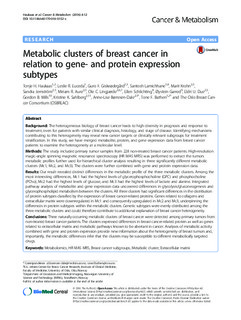| dc.contributor.author | Haukaas, Tonje Husby | |
| dc.contributor.author | Euceda, Leslie R. | |
| dc.contributor.author | Giskeødegård, Guro F. | |
| dc.contributor.author | Lamichhane, Santosh | |
| dc.contributor.author | Krohn, Marit | |
| dc.contributor.author | Jernstrøm, Sandra | |
| dc.contributor.author | Aure, Miriam Ragle | |
| dc.contributor.author | Lingjærde, Ole Christian | |
| dc.contributor.author | Schlichting, Ellen | |
| dc.contributor.author | Garred, Øystein | |
| dc.contributor.author | Due, Eldri Undlien | |
| dc.contributor.author | Mills, Gordon B. | |
| dc.contributor.author | Sahlberg, Kristine Kleivi | |
| dc.contributor.author | Børresen-Dale, Anne-Lise | |
| dc.contributor.author | Bathen, Tone Frost | |
| dc.contributor.author | (OSBREAC), Oslo Breast Cancer Consortium | |
| dc.date.accessioned | 2016-07-06T11:46:23Z | |
| dc.date.accessioned | 2016-07-08T07:11:36Z | |
| dc.date.available | 2016-07-06T11:46:23Z | |
| dc.date.available | 2016-07-08T07:11:36Z | |
| dc.date.issued | 2016 | |
| dc.identifier.citation | Cancer & Metabolism 2016 | nb_NO |
| dc.identifier.issn | 2049-3002 | |
| dc.identifier.uri | http://hdl.handle.net/11250/2396096 | |
| dc.description.abstract | Background:
The heterogeneous biology of breast cancer leads to high diversity in prognosis and response to treatment, even for patients with similar clinical diagnosis, histology, and stage of disease. Identifying mechanisms contributing to this heterogeneity may reveal new cancer targets or clinically relevant subgroups for treatment stratification. In this study, we have merged metabolite, protein, and gene expression data from breast cancer patients to examine the heterogeneity at a molecular level.
Methods:
The study included primary tumor samples from 228 non-treated breast cancer patients. High-resolution magic-angle spinning magnetic resonance spectroscopy (HR MAS MRS) was performed to extract the tumors metabolic profiles further used for hierarchical cluster analysis resulting in three significantly different metabolic clusters (Mc1, Mc2, and Mc3). The clusters were further combined with gene and protein expression data.
Results:
Our result revealed distinct differences in the metabolic profile of the three metabolic clusters. Among the most interesting differences, Mc1 had the highest levels of glycerophosphocholine (GPC) and phosphocholine (PCho), Mc2 had the highest levels of glucose, and Mc3 had the highest levels of lactate and alanine. Integrated pathway analysis of metabolite and gene expression data uncovered differences in glycolysis/gluconeogenesis and glycerophospholipid metabolism between the clusters. All three clusters had significant differences in the distribution of protein subtypes classified by the expression of breast cancer-related proteins. Genes related to collagens and extracellular matrix were downregulated in Mc1 and consequently upregulated in Mc2 and Mc3, underpinning the differences in protein subtypes within the metabolic clusters. Genetic subtypes were evenly distributed among the three metabolic clusters and could therefore contribute to additional explanation of breast cancer heterogeneity.
Conclusions:
Three naturally occurring metabolic clusters of breast cancer were detected among primary tumors from non-treated breast cancer patients. The clusters expressed differences in breast cancer-related protein as well as genes related to extracellular matrix and metabolic pathways known to be aberrant in cancer. Analyses of metabolic activity combined with gene and protein expression provide new information about the heterogeneity of breast tumors and, importantly, the metabolic differences infer that the clusters may be susceptible to different metabolically targeted drugs. | nb_NO |
| dc.language.iso | eng | nb_NO |
| dc.publisher | BioMed Central | nb_NO |
| dc.rights | Navngivelse 4.0 Internasjonal | |
| dc.rights.uri | http://creativecommons.org/licenses/by/4.0/deed.no | |
| dc.subject | Metabolomics – HR MAS MRS – Breast cancer subgroups – Metabolic cluster – Extracellular matrix | nb_NO |
| dc.title | Metabolic clusters of breast cancer in relation to gene- and protein expression subtypes | nb_NO |
| dc.type | Journal article | nb_NO |
| dc.type | Peer reviewed | nb_NO |
| dc.date.updated | 2016-07-06T11:46:23Z | |
| dc.rights.holder | © The Author(s). 2016 | nb_NO |
| dc.source.volume | 4 | nb_NO |
| dc.source.journal | Cancer & Metabolism | nb_NO |
| dc.source.issue | 12 | nb_NO |
| dc.identifier.doi | 10.1186/s40170-016-0152-x | |
| dc.identifier.cristin | 1365760 | |
| dc.description.localcode | © 2016 The Author(s). Open Access This article is distributed under the terms of the Creative Commons Attribution 4.0 International License (http://creativecommons.org/licenses/by/4.0/), which permits unrestricted use, distribution, and reproduction in any medium, provided you give appropriate credit to the original author(s) and the source, provide a link to the Creative Commons license, and indicate if changes were made. The Creative Commons Public Domain Dedication waiver (http://creativecommons.org/publicdomain/zero/1.0/) applies to the data made available in this article, unless otherwise stated. | nb_NO |

